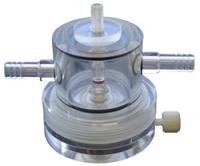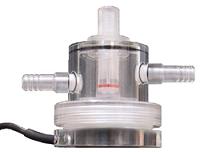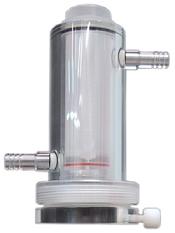DISSOLVED OXYGEN ELECTRODE CUVETTE (1 mL)
The 1 mL dissolved O2 electrode cuvette can be used to measure O2 exchange in respiring and/or photosynthesising organisms in an aquatic environment. It can also be used to measure O2 exchange in organelles (mitochondria and chloroplasts) as well as O2 production and/or consumption in chemical and biochemical reactions.

DISSOLVED OXYGEN ELECTRODE CUVETTE (4 mL)
The 4 mL dissolved O2 electrode cuvette can be used to measure O2 exchange in respiring and/or photosynthesising organisms in an aquatic environment. It can also be used to measure O2 exchange in organelles (mitochondria and chloroplasts) as well as O2 production and/or consumption in chemical and biochemical reactions.

DISSOLVED OXYGEN ELECTRODE CUVETTE (6 mL)
The 6 mL dissolved O2 electrode cuvette can be used to measure O2 exchange in respiring and/or photosynthesising organisms in an aquatic environment. It can also be used to measure O2 exchange in organelles (mitochondria and chloroplasts) as well as O2 production and/or consumption in chemical and biochemical reactions.

DISSOLVED OXYGEN ELECTRODE CUVETTE (30 mL)
The 30 mL dissolved O2 electrode cuvette can be used to measure O2 exchange in respiring and/or photosynthesising organisms in an aquatic environment. It can also be used to measure O2 exchange in organelles (mitochondria and chloroplasts) as well as O2 production and/or consumption in chemical and biochemical reactions.

DISSOLVED OXYGEN ELECTRODE CUVETTE (50 mL)
The 50 mL dissolved O2 electrode cuvette can be used to measure O2 exchange in respiring and/or photosynthesising organisms in an aquatic environment. It can also be used to measure O2 exchange in organelles (mitochondria and chloroplasts) as well as O2 production and/or consumption in chemical and biochemical reactions.

The water-jacketed oxygen electrode cuvette is made of plastic. The sample chamber sits on top of a base plate that incorporates platinum and silver electrodes, and is held in place by a threaded ring. Power to the electrodes, and the signal output, is conveyed by a cable that terminates in a BTA plug. The BTA plug is attached to a C410 LabPro Interface via an amplifier box. No external power supply is required for the oxygen electrode. A plunger slides into the sample chamber and is held in position by a threaded locking ring. A plunger serves to fix the volume of the sample, to exclude external oxygen from the sample, and to allow injection of chemical activators via a central injection port.
Producing Area:Canada